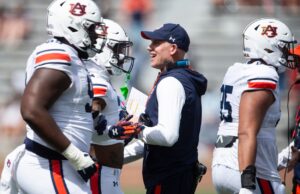College Football Ted Lasso Style?
Another day, another monumental change in the college football landscape. Within hours after rumors broke that USC and UCLA spurned the PAC-12 for the Big Ten, we received confirmation that the Big Ten was heading west. Certainly, the move makes financial sense for both sides. The Big Ten lands a massive viewership market while USC and UCLA get to share in a much larger conference payout. For the rest of the PAC-12, however, it signals choppy waters ahead. Indeed, given the similar move by Texas and Oklahoma to the SEC a year ago, realignment seems in full tilt. That got us thinking: if we are going to blow everything up, let’s tweak everything. What might realignment look like at the end of the day, and can we do college football Ted Lasso style?
Shedding Power Five for the Big Four
After the loss of Oklahoma and Texas, the Big 12 scrambled to add four quality teams. With the PAC-12 and its unique geography, finding a few quality teams within their territory may prove difficult. Boise State makes sense, but, outside of that, pickings are slim. Rumors abound, of course, that a couple more teams might follow USC and UCLA to the Big Ten. This would make a PAC-12 and Big 12 merger the most efficient option for the teams left standing to retain Power Five status.
Unfortunately, as is, the math does not work. The Big 12 will have 12 teams, and the Pac-12 would be left with eight or ten. Even in a super-conference environment, that many teams are unwieldy. So we looked at the math. As it stands now, the Power Five conferences, no matter who flees to where will total 68 (and 69 when including Notre Dame). That leaves two options. We could end up with four conferences with 16 teams each. That would give us a Big Four featuring 64 teams. Alternatively, we could end up with four conferences with 18 teams each. That would give us a Big Four with 72 teams.
For college football Ted Lasso style, we will assume a 72-team Big Four. That means the Big Four would add three more teams not currently in the Power Five (plus Notre Dame) alignment. Of the remaining teams out there, we like Boise State, Memphis, and Appalachian State for inclusion (though arguments could be made for a handful of others).
How Could the Conferences Align
Our foray into fantasyland assumes that Stanford and Oregon follow their league counterparts into the Big Ten. It believes that the next step is that the Big 12 agrees to jettison its easternmost teams to the ACC while merging with the remainder of the PAC-12. This would leave the Big 12 with nine teams after pushing West Virginia, Cincinnati, and UCF into the ACC. The ACC would also grab Notre Dame to leave it at an even 18.
The PAC-12 would have eight teams left in this scenario, the newly-merged Big 12/Pac-12 would stay under the Big 12 umbrella and add Boise State to bring them to an even 18. With its PAC-12 additions, the Big Ten would grow to 18. That leaves the SEC gobbling up Memphis and Appalachian State to bolster its footprint in the Southeast. Reborn as the Big Four, the conferences look like this.
| SEC | Big 12 | Big Ten | ACC |
| Alabama | Arizona | Illinois | Boston College |
| Appalachian State | Arizona State | Indiana | Cincinnati |
| Arkansas | Baylor | Iowa | Clemson |
| Auburn | Boise State | Maryland | Duke |
| Florida | BYU | Michigan | Florida State |
| Georgia | California | Michigan State | Georgia Tech |
| Kentucky | Colorado | Minnesota | Louisville |
| LSU | Houston | Nebraska | Miami |
| Memphis | Iowa State | Northwestern | North Carolina |
| Oklahoma | Kansas | Ohio State | NC State |
| Ole Miss | Kansas State | Oregon | Notre Dame |
| Mississippi State | Oklahoma State | Penn State | Pitt |
| Missouri | Oregon State | Purdue | Syracuse |
| South Carolina | TCU | Rutgers | UCF |
| Tennessee | Texas Tech | Stanford | Virginia |
| Texas | Utah | UCLA | Virginia Tech |
| Texas A&M | Washington | USC | West Virginia |
| Vanderbilt | Washington State | Wisconsin | Wake Forest |
No doubt given the current posturing over amateurism, NIL rules, and NCAA inconsistencies, the Big Four will break away from the NCAA. This lets the conferences decide upon a brand new framework for everything, including how the playoffs work. This is where Ted Lasso comes in.
Divisions Based on Success
As much as our futbol/soccer counterparts at Last Word on Sports would hate to hear this, we realize American knowledge of the complexities of soccer competition in Europe and elsewhere can be difficult to follow. That said, we know (at least we very much hope) that most of you have watched Ted Lasso (maybe even twice).
As Ted learned the hard way, not only are the rules different in soccer but across the European leagues, there are different levels of competition. Teams can earn advancement into the more competitive league by performing well enough to advance. On the other hand, teams can be relegated by performing poorly. No team is truly safe from relegation (though, practically, some have avoided it for a long, long time).
Doing college football Ted Lasso style involves each conference having two divisions, A and B. Division A teams are eligible for the playoff to decide the national champion. Division B teams are not. Instead, Division B teams play to advance.
How would conferences decide which teams slot in which division? Well, that can be left to the individual conferences, but a more predictable model would simply be to determine which teams have won the most regular-season games over the last five seasons. That would provide the initial framework for division.
For teams that have been independent or came from current G5 leagues, however, they would automatically be placed in the B-division. It may seem unfair, but the income jump for those schools would still be substantial, and comparing their wins to wins by their long-time Power Five counterparts does not offer an equal measuring stick. That said, B-division teams can always play their way into the A-division. It can happen in as soon as a single season.
What That Looks Like Today
We looked at the win totals for teams in each conference and went ahead and set up Division A and Division B in each conference. Here is what that looks like.
| SEC | Big 12 | Big Ten | ACC |
| Division A | Division A | Division A | Division A |
| Alabama | Oklahoma State | Ohio State | Clemson |
| Oklahoma | Utah | Michigan | Miami |
| Georgia | Iowa State | Iowa | NC State |
| LSU | Washington | Penn State | Pitt |
| Texas A&M | Washington State | Wisconsin | Wake Forest |
| Auburn | TCU | Oregon | Virginia Tech |
| Florida | Arizona State | Michigan State | Virginia |
| Kentucky | Baylor | Minnesota | Boston College |
| Texas | Kansas State | USC | West Virginia |
| Division B | Division B | Division B | Division B |
| Arkansas | California | Northwestern | Louisville |
| Ole Miss | Texas Tech | Stanford | Florida State |
| Mississippi State | Colorado | Purdue | North Carolina |
| Missouri | Oregon State | Indiana | Syracuse |
| South Carolina | Arizona | UCLA | Duke |
| Tennessee | Kansas | Maryland | Georgia Tech |
| Vanderbilt | BYU | Illinois | Notre Dame |
| Memphis | Houston | Nebraska | Cincinnati |
| Appalachian State | Boise State | Rutgers | UCF |
Again, some fan bases will be understandably upset with the results. That said, their teams can make the jump in just a single season by winning.
Advancement and Relegation
Here at Last Word on College Football, we looked at the concept of relegation over four years ago. This time, we take a different look based on the shifting landscape and how things could easily unfold. This time around, we have divisions with nine teams. Each team plays all other teams in their division once, with four home games and four away games. Each team in the Big Four will also play one out-of-conference game against a Division A team and one against a Division B team. For the purpose of advancement and relegation, however, these games do not matter.
At the end of the season, there will be two separate playoffs. One decides the National Champions; the other decides who advances and relegates. The bottom two teams in Division A and the top four teams in Division B will then play a tournament for spots in each Division. Two teams advance; two teams get demoted.
The tournament will give the Division A teams a bye for the first round. The four Division B teams will play each other in seeded contests. The winners face the teams with bye weeks in round two. If a Division A team loses, that team faces relegation. If no Division A team loses the tournament, then the divisions remain unaffected. However, if both Division A teams lose, then the Division B teams both advance but they still play the final game to determine schedule strength the following season. That is college football Ted Lasso style.
The Playoffs
On the other side of the equation, we have the actual playoff to determine the National Champions. The top four teams from Division A of each conference will play in a seeded tournament. Seeds will be awarded based on a simple metric: the top team in each conference vies for seeds one through four, and so on down the line. To split hairs between the top teams in each conference, we rely on the overall record. The team with the most wins gets the higher seed. If there are ties, then the team whose opponents have won the most games wins the tiebreaker. 16 teams will then play a four-round tournament.
Some of the arguments against an expanded playoff centered on season length. Adding two or three more games increases injury risk for players who only have so much sanctioned practice time in a year. The schedule we envision solves that. The regular season features just ten games. Eight games will always be against the other teams in the same division of the same conference. One game will be against a Division A team outside of the conference. The other will be against a Division B team outside of the conference. All teams get a bye week after game five, and all teams get a bye week before playoffs begin.
Why College Football Ted Lasso Style?
Make no mistake: this uniformity can also come with various other approaches to ultimate realignment. That said, another approach some favor is a two-conference super-league. We already have that: the NFL. Even with its changes to incorporate NIL compensation and a transfer market similar to free agency, college football still has its traditions. It remains a training ground for future professional players to prove their skills. Keeping the game centered on two super conferences loses sight of that. Allowing four conferences keeps more fans and more teams and more players involved in meaningful football.
In this way, we can blow it up without losing the spirit of collegiate competition.






